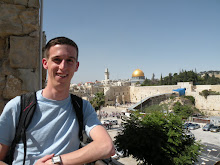I'm hoping to do one more blog to wrap everything up - reflections, etc. Maybe in the next week or so. Until then, enjoy this blog's and the last blog's pictures!

St. Paul Outside the Walls, where St. Paul is buried!

Nuns venerating the chains which are believed to have held Paul in prison in Rome

Gladiator fighting in the Roman Colosseum!

This cross was erected to remember the Christian martyrs in the Colosseum. In 1749, Pope Benedict XIV declared the Colosseum (officially, the "Flavian Ampitheater") as a sacred site.

Group in front of the Colosseum

The Arch of Titus - built to commemorate Titus' sack of Jerusalem in 70 AD. We have come full circle! Titus used funds from the destruction of Jerusalem to build the Flavian Ampitheater (Colosseum).

The inscription on the top of the Pantheon - "M. Agrippa," which stands for Marcus Agrippa, who commissioned construction of the Pantheon.

The inside of the Pantheon with its recognizable hole at the top of the dome. Absolutely stunning!

Throwing coins over our shoulders into the Trevi Fountain to ensure our return to Rome!

Getting my caricature drawn! It ended up being a little scandalous in the end!

Some friends in front of the Fountain of Four Rivers in the Piazza Navona - the center of Rome nightlife. Get some gelato, relax in the Navona, stroll the streets - we were told that's a very "Roman" thing to do! So when in Rome...
We also got to see Bethany and Abby Wilson while we were in Rome! (on the right - Bethany is a college friend, not in our program)

Piazza Navona at night

Vatican Museum entrance

Laocoon statue - stunning. This figure inspired Michelangelo in his painting of the Sistine Chapel, which is located at the end of the Vatican Museums (you can't take pictures in the Sistine Chapel, but it was absolutely marvelous!).

The Map Room in the Vatican Museums

The dome of St. Peter's!

The canopy over the tomb of St. Peter - only the Pope can officiate Mass from this altar.

Jumping in St. Peter's square

A sign that explains the Christian fish symbol as an acrostic - "Ἰησοῦς Χριστός, Θεοῦ ͑Υιός, Σωτήρ" means "Jesus Christ, Son of God, Savior." Taking the first letter of each of those five words in Greek, we spell out "ichthys," the Greek word for fish. The ☧ symbol that you see on the right hand side of the sign is the "chi-rho" symbol. "Chi" (X) and "rho" (p) are the first two letters of the word "Christ" in Greek. If you superimpose a X (chi) on the p (rho), you form the chi-rho symbol. This symbol has been used massively throughout history as a symbol of Christianity. Constantine is said to have chosen the symbol after he won the Battle of Milvian Bridge in 312 AD, giving him control of Rome. (The Milvian Bridge was over the Tiber River, which flows through what is now the heart of Rome.) Pope John Paul II (who died in 2005) has one and only one symbol on his grave: the chi-rho.

Eating pasta as a group at a great restaurant (Pastini) just across from St. John in Lateran, the cathedral of the Church of Rome.

On our free day, we ran into Meredith Melby, another friend from school that is not in the program. But this was totally unplanned - in the middle of Rome! Crazy! God is so good. So seven of us took a day trip to Tivoli, about an hour outside of Rome, where we visited the Villa D'Este, a 16th century villa with hundreds of fountains and organized gardens. It was absolutely beautiful! And very relaxing and nice to get away from the all the heat and tourists in Rome. Whenever I travel, I love to see the surrounding countryside - and I'm always glad I do! The next 5 pictures are all from Villa D'Este.





This flower inspired the development of the Corinthian column!

We ended our free day by visiting the crypt of the Church of the Immaculate Conception in the Barberini area of Rome. The church is unique because they preserve all the bones of monks who have lived there/served the church. In fact, they've made chapels in the crypt area out of the bones of the monks! It creates an eerie atmosphere, as you might imagine. This and the next two pictures show how they use these bones! What do you think?!



Last night in Rome - the seniors say goodbye!
Peace.

No comments:
Post a Comment